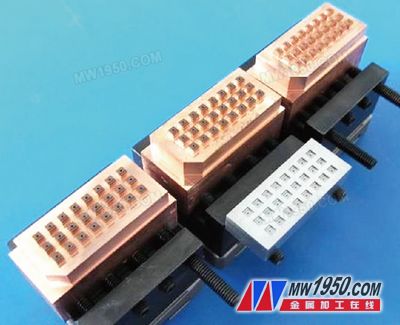Does high-speed milling replace traditional EDM? In order to find out, the metal processing online reporter learned about the latest technology from GF AgieCharmilles, Switzerland, and compared the processing capabilities of high-speed milling and EDM processing from the aspects of workpiece structure, machining accuracy, machining materials and processing speed. Advantages and disadvantages and applicable space.
The two complement each other and cooperate with each other
In general, high-speed milling and EDM can't replace each other, but complement each other and cooperate with each other.
With the development of high-speed milling technology in recent years, parts that were traditionally processed by EDM can now be converted to high-speed milling. For example, the original milling process can only process unhardened materials, while hardened materials can only be processed by EDM.
Now, high-speed milling technology can directly process materials with a hardness of 52HRC or higher. Previously, these parts were machined by milling machines and finally formed by EDM machines, which was time-consuming and labor-intensive. Some parts that require large-area processing are now directly processed by high-speed milling, which greatly improves the efficiency, because if EDM is used, not only the electrode needs to be processed, but also the efficiency of the milling machine is much higher than that of the EDM in large-area processing. Moreover, it is required to process a very low surface roughness value, such as R a = 0.2 μm, which is difficult to achieve by EDM, and the surface roughness value R a of high speed milling can be as high as 0.1 μm. But in some ways, high-speed milling has limitations.
For example, a small clearing process is required, and a high-speed milling machine requires a tool of a small diameter, which is not easy to machine and is easy to break.
At this time, it is preferable to machine a small electrode by a milling machine and then to perform electric discharge machining.
For example, some very hard materials, such as hardness above 62HRC or even cemented carbide materials, are directly processed by high-speed milling, which is not only laborious, but also the cost of the tool rises linearly. The best processing route is high-speed milling of electrodes, and EDM last. Forming processing. Therefore, the two processing techniques cannot be completely replaced with each other, but complement each other.
Typical case for application in mold making
High-speed milling and EDM are widely used in electronics and other industries, and are the key processes and technologies in mold processing. Now take the current very popular LED mold processing as an example to talk about the role of high-speed milling and EDM in such molds. As shown in Figure 1.

figure 1
The workpiece requires Elmax (hardness 56HRC), 24 cavities 3mm × 3mm, depth 0.6mm, no pre-milling, surface roughness Ra is less than 0.1μm, bottom fillet is less than 0.03mm, cavity size accuracy is ±2μm , position error ± 2μm.
Obviously, this workpiece cannot be completely milled by high speed because it requires excellent local precision and very small fillets. We consider the fabrication of electrodes by high-speed milling, which is finally completed by EDM. Due to the high processing requirements of the workpiece itself, the quality of the electrode is first high. It has several difficulties: First, the machining accuracy, the dimensional accuracy and position accuracy of the electrode are less than 2μm; the second is that the surface quality is very good, and there is no burr; the third is the need for good local precision, which requires high-speed milling machine Very good jerk (Jerk). This has not been done with traditional high speed milling machines. To this end, we used GF AgieCharmilles' latest HSM400LPP machine to complete. The machine is driven by a linear motor, eliminating the backlash caused by the ball screw. The machine has an extremely high accuracy with an error of 0.1 μm. Equipped with a high-speed electric spindle of 42 000r/min. The time taken to machine one electrode from the machine was 169 min. EDM is done by AgieCharmilles' FO350MS machine. The machine bed is equipped with a thermal constant system, four intelligent modules, and all work is completed with only three electrodes. The final processing result roughness value R a = 0.06 μm, the bottom fillet R 0.022 mm, all used only 550 min. It can be said that the processing of this workpiece fully reflects the processing direction of the current high-end mold: a completely matched processing equipment combination, as described above, high-precision high-speed milling and high-precision electric spark are completely combined, not only high precision, but also high efficiency. .
Our Sparklet Optic Fiber introduces a light diffusion technology that achieves brilliant and distinctive sparkling effect without any noticeable reduction in the intensity of the light throughout entire length of cable travel. The Fiber optic strands are encased in a flexible clear UV stabilized PVC jacket to create fiber tail bundles in a variety of diameters for different type of projects. These fibers are best suited for sparkling effects, neon like effects, decorative lighting, chandeliers, and light
Sparkle Fiber Optic,Fiber Optic Strands,Fiber Lights,Sparkle Fiber Optic Cable
Jiangxi Daishing POF Co.,Ltd , https://www.opticfibrelight.com